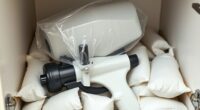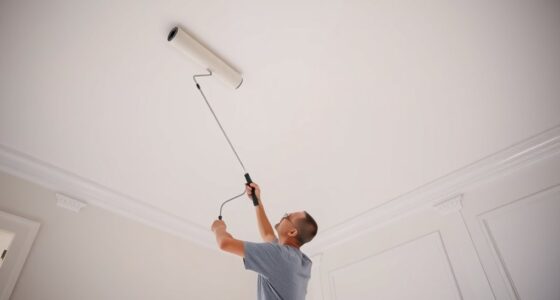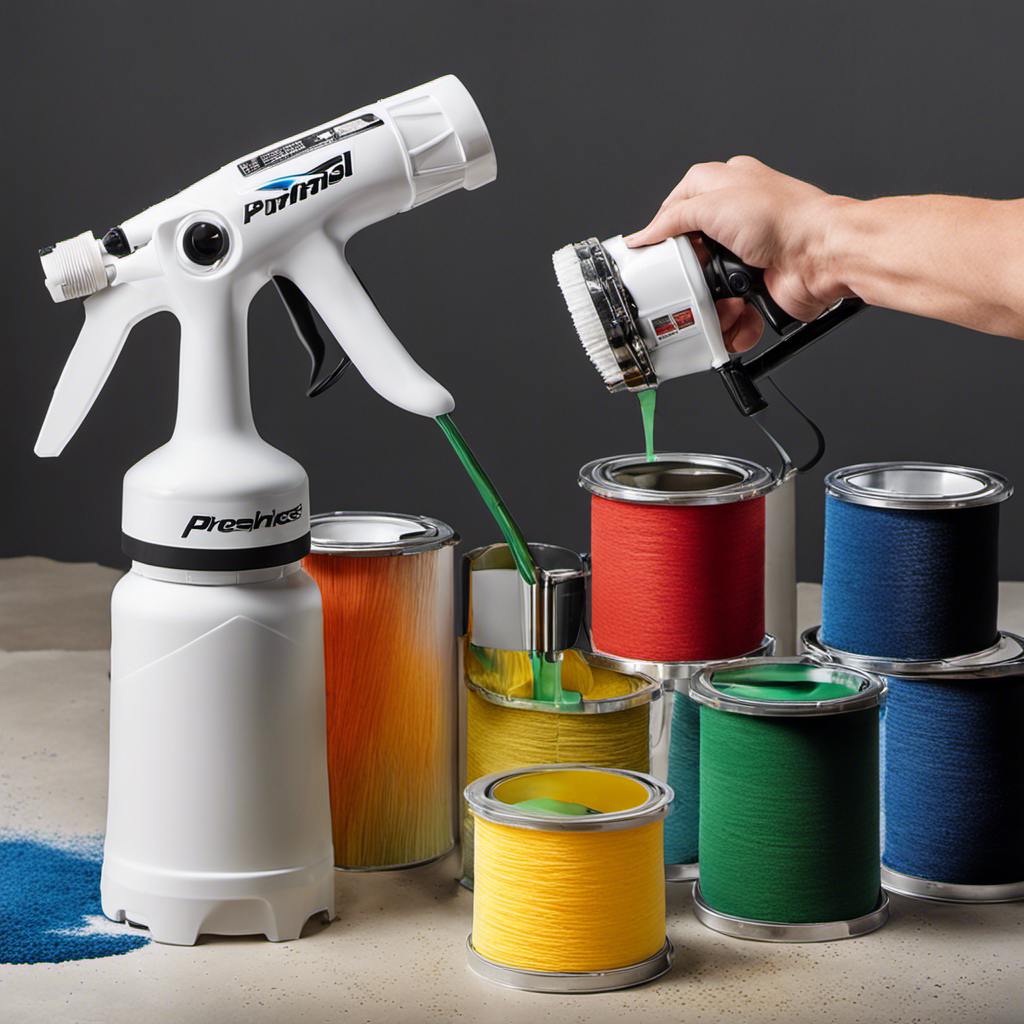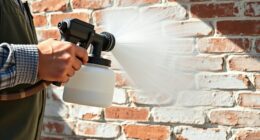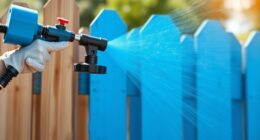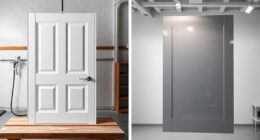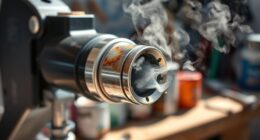Yes, you can spray oil-based paint with an airless sprayer if you properly thin the paint and guarantee your equipment is well-maintained. Thinning helps prevent clogging and creates a smooth, even spray pattern, while regular cleaning keeps everything functioning smoothly. When done correctly, this method offers professional results quickly and efficiently. If you want to learn more about achieving the best finish with oil-based paints, keep exploring the key tips below.
Key Takeaways
- Yes, airless sprayers are specifically designed to handle oil-based paints effectively.
- Proper thinning of oil-based paint with mineral spirits ensures smooth spraying and prevents clogging.
- Maintaining the equipment and cleaning components after use helps achieve professional results.
- Testing and adjusting the paint viscosity ensures optimal spray pattern and coverage.
- Using an airless sprayer speeds up application on large surfaces with a durable, even finish.
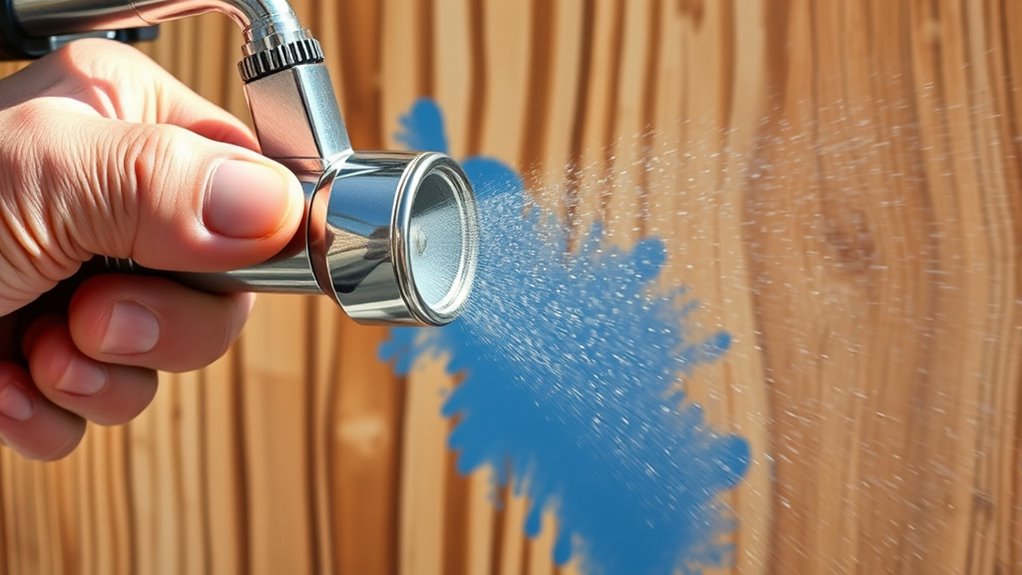
Spraying oil-based paint with an airless sprayer can be an efficient way to achieve a smooth, professional finish on large surfaces. However, before you begin, it’s vital to understand how the paint’s consistency impacts your spraying process. Oil-based paints tend to be thicker than water-based options, which can cause clogging or uneven spray patterns if not properly prepared. To guarantee ideal results, you need to thin the paint to the right consistency—usually by adding the manufacturer’s recommended amount of solvent or mineral spirits. This thinning allows the sprayer to pump the paint smoothly and atomize it into fine droplets, resulting in a uniform coat. Keep in mind that if the paint is too thick, it can lead to sputtering, uneven coverage, or paint buildup, while overly thinning it might cause drips or a less durable finish. Finding that balance is key; test the consistency by running a small amount through the sprayer and adjusting as needed until the spray pattern is even and the paint flows without resistance. Properly preparing and maintaining your equipment is essential for consistent results and a professional-looking finish.
Once you’ve achieved the proper paint consistency, maintaining your sprayer becomes vital for a successful project. Regular sprayer maintenance isn’t just about prolonging the life of your equipment; it’s also about guaranteeing the quality of your finish. Before starting, thoroughly clean all components—tips, filters, and hoses—to remove any residual paint or debris. After each use, flush the system with the appropriate solvent to clear out paint residues and prevent clogging. Pay close attention to the spray tip, as dried paint can clog or alter spray patterns if not cleaned properly. Additionally, inspect the seals and gaskets periodically to prevent leaks and maintain consistent pressure during spraying. Proper maintenance reduces the risk of sputtering, uneven spray, or equipment failure, which can compromise your work. Using the right paint consistency is equally important for achieving a smooth and even application.
Incorporate routine checks into your workflow, especially when working with oil-based paints, which tend to be more viscous and prone to causing buildup. Keeping the sprayer clean and well-maintained allows you to spray smoothly, efficiently, and with minimal downtime. This not only saves you time but also guarantees a professional finish. Remember, a well-maintained sprayer paired with correctly thinned paint will give you consistent, even coverage and a superior end result. So, take the time to prepare your paint and care for your equipment, and you’ll find that spraying oil-based paint with an airless sprayer is both practical and highly effective.
Frequently Asked Questions
Can Oil-Based Paint Clog the Airless Sprayer Nozzle?
Oil-based paint can clog your airless sprayer nozzle if you’re not careful. Nozzle clogging often occurs due to paint consistency and improper cleanup, so it’s vital to verify paint compatibility with your sprayer. Use a filter to prevent debris, thin the paint if needed, and clean the nozzle thoroughly afterward. Proper preparation and maintenance help avoid clogs and ensure smooth, even application.
How Long Does Oil-Based Paint Take to Dry After Spraying?
Drying oil-based paint is like waiting for a slow sunset; it takes time. Typically, it dries to the touch in 6 to 8 hours, but full curing can take 24 to 48 hours. Environmental factors like humidity, temperature, and ventilation greatly influence the drying time. To guarantee the best results, give it ample time to dry thoroughly before handling or applying a second coat.
Is Thinning Oil-Based Paint Necessary for Airless Spraying?
You should consider paint consistency and thinning requirements before spraying oil-based paint. Thinning oil-based paint isn’t always necessary, but if your paint is too thick, it can clog your sprayer or cause uneven coverage. Check the manufacturer’s recommendations; usually, adding a small amount of mineral spirits or paint thinner helps achieve the right consistency. Proper thinning ensures smooth application and prevents equipment issues.
What Safety Precautions Should I Take When Spraying Oil-Based Paint?
When spraying oil-based paint, you should prioritize safety by wearing protective gear like masks, goggles, and gloves to prevent paint fumes from harming you. Make certain there is good ventilation in your workspace to disperse fumes quickly. Keep the area clear of sparks or flames, as oil-based paints are flammable. Always follow manufacturer instructions, and wash up thoroughly afterward to avoid inhaling paint fumes or skin contact.
How Do I Clean an Airless Sprayer After Using Oil-Based Paint?
Imagine you’re a knight preparing for battle, and your trusty steed is your sprayer. After spraying oil-based paint, you need to follow proper cleaning procedures to prevent clogs and guarantee paint compatibility. First, turn off and depressurize the sprayer. Then, use mineral spirits or a solvent recommended for oil-based paints to thoroughly clean all parts. Rinse with water if needed, and store the sprayer properly for next use.
Conclusion
So, can you spray oil-based paint with an airless sprayer? Absolutely, but you need to prepare properly and use the right techniques. With the right adjustments and maintenance, you’ll achieve a smooth, professional finish that makes your project stand out. Imagine transforming your space effortlessly—doesn’t that make you want to give it a try? Just remember, with a little patience and care, your paint job can look flawless and save you time in the end.
Franz came aboard the Paint Sprayer Zone team with a background in both journalism and home renovation. His articulate writing style, combined with a passion for DIY projects, makes him an invaluable asset. Franz has a knack for breaking down technical jargon into easy-to-understand content, ensuring that even the most novice of readers can grasp the complexities of paint sprayers.

